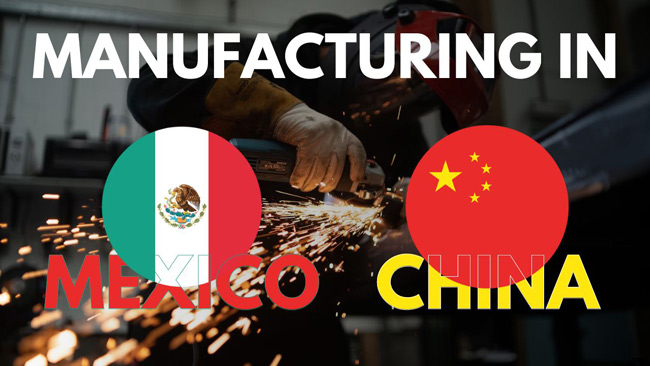A Comparative Analysis of Manufacturing in Mexico vs China
- Date:
- Author: SVI Content Team
- Share:

Manufacturing is a vital component of global economic activity, and countries like Mexico and China have emerged as major players in the industry. With their significant manufacturing capabilities, these countries attract businesses seeking cost-effective production, access to large consumer markets, and favorable trade agreements. However, when it comes to manufacturing in Mexico vs China, which is the wise choice for you?
Here’s an overview and comparison of manufacturing in China and Mexico. It shows you the different advantages in these two countries by examining factors such as labor cost, trade agreements, and delivery time. With this analysis, businesses can make informed decisions about where to establish their manufacturing operations.
Part 1. Pros and Cons of Manufacturing in Mexico and China
How Did Mexico Emerge as a Rising Manufacturing Nation?
Mexico has experienced remarkable growth as a rising manufacturing hub, as evidenced by the latest statistics revealing its position as the top trading partner of the United States in 2023 and 2024.
Mexico is the largest source of imports for the United States. According to the U.S. Census Bureau, in 2024, over 70% of goods were exported to the U.S., with a total value of $506 billion. Two-way U.S.–Mexico trade exceeded $839 billion that year. And the U.S. imported about $264 billion in goods from Mexico in the first half of 2025.
⭕ Pros of manufacturing in Mexico:
- Proximity to the United States market
- Skilled and cost-effective labor
- Favorable trade agreements
- Strong industry cluster in automotive, aerospace, etc.
❌ Cons of manufacturing in Mexico:
- Higher and rising labor costs compared to countries in Asia
- Lack of logistical and utility support in remote areas
- Some regions encounter the challenges of higher security concerns
What Makes China an Advantaged Country in Manufacturing?
China has been the global leader in manufacturing for decades. And China has been one of the major partners with America. In 2024, the US imported products from China with a total value of about $439 billion. While in the first half of 2025, the total value of imports from China was about $167 billion.
⭕ Pros of manufacturing in China:
- Large labor force
- Cost advantages in production
- Established infrastructure for manufacturing
- Extensive supply chain networks
- Advanced technological capabilities and innovation
❌ Cons of manufacturing in China:
- Trade friction that causes uncertainty with U.S.
- Longer transit times to ship cargoes
- IP & compliance concerns
Part 2. What Factors to Be Considered When Comparing Mexico vs China Manufacturing
The manufacturing prowess of China, often hailed as the world’s factory, has been undeniable. However, the world trade landscape is in a state of flux. A new player has emerged on the stage of manufacturing, and it’s none other than Mexico, strategically located close to the United States.
When evaluating whether to move production from China to Mexico, it’s important to weigh industry strengths, supply chain depth, and long-term growth potential in both countries.
1. Prominent Industries
Mexico:
Mexico’s manufacturing sector is also very involved in a wide range of industries, including automotive, aerospace, electronics, medical devices, and more. Among them, the most remarkable is the automotive industry.
Mexico is a major automobile manufacturer, where 89 of the world’s top 100 auto parts producers are located. Its automotive prowess has attracted the attention of major companies like Tesla, BYD, Chery, and SAIC to expand opportunities there.
For example, Tesla announced the plans in 2023 to invest a staggering $5 billion in Mexico. And in June 2025, Mexico’s export revenue rose 10.6% year-on-year, and the growth is due to the manufacturing industry, while Automotive exports rose 4.5% to $16.3 billion despite U.S. tariffs, with U.S.-bound shipments up 6%.
Major industries in Mexico:
- Automotive
- Electronics
- Machinery & Equipment
- Pharmaceuticals & Medical Devices
- Aerospace & Aviation
China:
With years of experience in industrialization, China’s manufacturing has developed a well-established supply chain ecosystem and covers a wide spectrum of sectors, including both high-tech and traditional industries.
And its economy still continued to grow in the first half of 2025 with the strong expansion in manufacturing.
Major industries in China:
- Electronics & Telecommunications
- Machinery & Equipment
- Automotive
- Textiles and Apparel
- Chemicals
2. Labor Costs
Mexico:
In December 2024, the Mexican government announced to increase 12% of daily minimum wage for workers.
- General Regions: The daily minimum wage is MXN$278.8 (about USD$15); the monthly minimum wage totals about MXN$8,364 (USD$452)
- Northern Border Free Zone: The daily minimum wage is MXN$419.88 (about USD$22.65); the monthly minimum wage totals about MXN$12,596 (USD$680)
China:
China, once renowned for its exceptionally low labor costs, has experienced a notable shift in recent years. As China’s manufacturing industry has gained momentum, the cost of labor has been increasing over time.
According to recent data reports, the monthly minimum wages of major provinces and cities in China ranged from RMB 1,700 to 2,740 (about USD$236 to $381).
3. Labor Force
Mexico:
Mexico, with a population of nearly 131 million in 2024, demonstrates a different labor force dynamic.
According to the report from OECD, Mexico’s unemployment rate stood at 2.8% in May 2025, one of the lowest across member countries and continuing a four-year downward trend. Meanwhile, the force participation was 65.4% in Q1 2025.
With a young demographic profile compared to many developed nations, Mexico benefits from a steady pipeline of workers for manufacturing.
China:
China, one of the world’s most populous countries, holds a population of about 1.41 billion in 2024.
It is dominant in numbers when it comes to its labor force. In 2022, the workforce was 768.6 million, but by 2024 this had declined to 734.4 million, according to Statista.
The labor force participation rate is about 65.4%. However, China faces a long-term demographic challenge: its working-age population is shrinking, driven by an ageing society and lower fertility rates. This trend may tighten labor supply and push wages upward in the coming years, impacting its cost advantage.
4. Trade Agreements & Policy
Mexico:
In the evolving global industrial supply chain picture, a noteworthy strategy has emerged: the “Excluding China” strategy led by the United States. Interestingly, this strategy has made neighboring Mexico an important beneficiary in nearshoring trends.
Several key developments have contributed to Mexico’s rise. For example:
- 2020: The signing of the United States-Mexico-Canada Agreement (USMCA).
- 2022: The U.S. government’s implementation of the CHIPS and Science Act further reinforced this trend.
- 2023: An executive order limits investment in China’s high-tech industries.
- 2018 to present: The U.S. government began imposing tariffs of 25% on Chinese imports in 2018, a measure that remains in place today.
China:
China saw the importance of building its trade partnerships with other countries. It continues to benefit from regional trade agreements across Asia, yet its U.S. ties face increasing uncertainty.
- Regional Comprehensive Economic Partnership (RCEP) in 2022: RCEP promotes tariff reductions, harmonized regulations, and more in 15 member countries across the Asia-Pacific region.
- Bilateral FTAs: China has signed, or is implementing, FTAs with numerous countries including Australia, South Korea, Singapore, New Zealand, and more.
- China–ASEAN FTA 3.0: Upgraded to include digital economy, green economy, and deeper supply-chain integration. Scheduled for approval in late 2025.
- U.S.–China Trade Tensions: Tariffs on Chinese imports remain high, currently capped at 30% through a temporary truce valid until November 2025.
5. Productivity
Mexico:
Mexico’s manufacturing productivity has improved in recent years, but it is still concentrated in labor-intensive and mid-value industries. Compared with China, its supply chain network is less extensive, and gaps remain in logistics and infrastructure, which can affect efficiency for some consumer products. It will also import raw material from China to manufacture products.
While it may not boast the same vast infrastructure as China, Mexico’s manufacturing sector has gone through a notable transformation. Collaborating with its North American neighbors, it is repositioning itself as a major player with large-scale capacity in industries such as automotive and electronics.
China:
China, renowned for its well-established supply chains and comprehensive transportation infrastructure, stands as a symbol of flexible production capabilities and operational efficiency.
Its large population and extensive industrial infrastructure allow manufacturers to handle everything from small-batch, low-cost runs to high-volume, complex production.
And with a focus on shifting from low-end to high-end manufacturing, China is investing in automation, robotics, and cutting-edge digital technologies to revolutionize its manufacturing sector and take productivity to new levels.
6. Shipping
Mexico:
When it comes to the efficient delivery of goods between China vs Mexico, the geographic advantage of Mexico for manufacturers targeting the North American market cannot be overstated.
With its proximity to the United States, the lead times of goods from Mexico is remarkably shorter compared to China. This advantage is amplified by Mexico’s strategic positioning, bordered by the Atlantic and Pacific Oceans, which grants easy access to numerous seaports, facilitating seamless trade with North America and Europe.
Goods can be shipped by truck or rail across the border in just 1–3 days, dramatically reducing transit times and costs compared to overseas shipments. The swift delivery timeframe allows manufacturers to meet tight deadlines, reduce inventory costs, and provide outstanding service to their customers.
China:
On the other hand, China, with its expansive territory, boasts a well-developed transportation system encompassing an extensive network of seaports and airports. However, due to the considerable distance to the USA, shipping products from China to U.S. poses challenges both in cost and time.
To expedite shipments from China to the U.S., the fastest option is often air freight or courier services. Generally, it takes 5 to 10 days to receive your packages. While these methods offer speed, they come at a higher cost.
And the ocean freight from China to the destination in America can take 15 to 50 days, based on different transportation modes.
7. Communication
Mexico:
Mexico is only one hour behind Eastern Standard Time, which provides more favorable conditions for communication. This time proximity eases the coordination of meetings and facilitates real-time interactions between Mexican and American counterparts. Mexico’s official language is Spanish, but interestingly, unlike Chinese, which is ideograph, Spanish is just as phonological as English, and coupled with the interest in learning Spanish in the USA, the linguistic compatibility makes Mexico an option for businesses seeking effective communication.
China:
The contrasting time zones between China and the U.S. present a unique challenge to effective communication.
China’s time zone is 12 hours ahead of the U.S. Eastern Time, and organizations must navigate this time difference to ensure that meetings and conversations are seamless. Furthermore, the linguistic and cultural disparities between China and America add an extra layer of complexity, making effective communication a captivating puzzle to solve.
8. Intellectual Property Protection
Safeguarding intellectual property (IP) is of paramount importance whether you’re outsourcing your operations or setting up your own factories.
Mexico:
With the entry into force of the Comprehensive and Progressive Agreement for Trans-Pacific Partnership (CPTPP) and the USMCA in Mexico, the Mexican intellectual property system has been revised. It has made efforts to strengthen intellectual property protection, including aligning its laws with international standards and participating in international treaties.
China:
Intellectual property protection in China has been a longstanding concern for many businesses due to past challenges. However, the Chinese government has taken steps to improve IP protection and enforcement.
In 2020, the United States and China embarked on a Phase One trade deal, marking a significant milestone in their complex economic relationship. The agreement addressed several structural issues related to intellectual property protection, forced technology transfer, currency manipulation, and market access barriers.
China pledged to improve its IP protection framework, strengthen enforcement mechanisms, and take measures to prevent the forced transfer of technology from foreign companies.
Part 3. Comparison Tablet: Manufacturing in China vs Mexico
| Category | China | Mexico |
|---|---|---|
| Population (2024) | 1.41 billion | 131 million |
| Labor Force (2024) | 734.4 million | 59 million |
| Labor Rate | 65.4% | 59.8% |
| Labor Costs | 2025 Monthly minimum wage: ranges from RMB 1,700 to 2,740 (USD $236 to 381), varies by province |
Daily minimum wage: MXN 278.8 (USD $15) for general regions; MXN 419.88 (USD $22.7) for Northern Border Free Zone |
| Trade with US (2024) | ✔ Exports to US: USD$439 million ✔ Imports from US: USD$143 million |
✔ Exports to US: USD$506 million ✔ Imports from US: USD$334 million |
| Geographical Location | Located in East Asia, bounded by the Pacific Ocean to the east and the Indian Ocean to the southwest | Located in southern North America, neighboring the United States to the north and bordering the Pacific and Atlantic Oceans |
| Shipping Time to US | ✔ Air freight: 5 to 10 days ✔ Ocean freight: over 15 days |
1 to 3 days by road |
| Prominent Industries |
Among the diverse industries in China, which excel: ✔ Electronics and Telecommunications ✔ Machinery & Equipment ✔ Automotive ✔ Textiles and Apparel ✔ Chemicals |
✔ Automotive ✔ Electronics ✔ Machinery & Equipment ✔ Pharmaceuticals & Medical Devices ✔ Aerospace & Aviation |
| Trade Agreements & Policy | ✔ Phase One trade agreement ✔ RCEP (Regional Comprehensive Economic Partnership) ✔ ASEAN trade deals ✔ Belt & Road Initiative |
✔ The United States-Mexico-Canada Agreement (USMCA) ✔ Comprehensive and Progressive Agreement for Trans-Pacific Partnership (CPTPP) |
| Productivity | Quick | Slower than China |
| Infrastructure | Sophisticated and mature | Less developed |
| Intellectual Property Protection | Improving its IP protection framework | Well-founded and strengthened |
| Language | Chinese | Spanish |
| Time Zone | 12 hours ahead (UTC+8) | 1 hour behind (UTC-6) |
FAQ about China and Mexico Manufacturing
Q1. Which region is better for manufacturing?
If you are in the major manufacturing sectors in Mexico, like automotive, and you need fast delivery to the U.S. market and lower shipping costs, Mexico is the better choice. It is good for manufacturing devices or components for big devices. Its proximity makes it ideal for nearshoring.
While China still dominates in scale, supply chain depth, and advanced manufacturing capabilities. Leaving aside the volatile tariff policy, from the perspective of the objective industry outlook and stable factors, China is the best candidate for high-volume production, low-cost products, and complex electronics.
Q2. Will Mexico overtake China in manufacturing?
Unlikely in the short term. China has decades of investment in infrastructure, skilled labor, and global supply chains that give it a significant edge.
Mexico is rapidly growing, especially in automotive, aerospace, and electronics, supported by nearshoring trends. As the global supply chain develops, many companies are diversifying by keeping part of their production in China while expanding capacity in Mexico to reduce supply chain risks.
Q3. What about the tariffs of U.S.-China and U.S.-Mexico?
2025 has been a turbulent year for global supply chains, with new tariffs from the U.S. reshaping trade flows. While rates and product categories continue to shift during negotiations, some goods, like steel, aluminum, and copper, remain subject to higher duties. Importers should always confirm the latest tariff schedules through government or consulate updates.
US tariffs with Mexico
So far, the U.S. has wanted to impose a 25% tariff on most imports from Mexico. But later, the two countries agreed to a series of temporary pauses and negotiated for a broader agreement. The most recent extension of the U.S.-Mexico 90-day pause was announced on July 31, 2025.
While USMCA generally maintains tariff-free trade on a vast majority of goods, the non-USMCA goods have a potential increase to a 30% tariff if the deal is not reached.
US tariffs with China
The US has implemented a variety of tariffs on Chinese imports, with the overall effective tariff rate on Chinese goods standing at approximately 30%. This rate is the result of a temporary trade truce in effect from August 10 to November 10, 2025.
Earlier in April, tariffs spiked as high as 145%, causing major supply disruptions. And still, both countries continue to link tariff discussions to broader geopolitical and economic concerns.
Plus: The U.S. has canceled the “de minimis” provision, which was previously duty-free for small-value shipments. This will have an impact on direct-to-consumer businesses.
Conclusion
The trend of moving manufacturing from China to Mexico has gained attention. We’ve thoroughly developed the blog about manufacturing in China vs Mexico, and specified the aspects like labor cost and geopolitical considerations that companies should research before outsourcing to Mexico vs China.
Whether it’s the strategic proximity to the United States and favorable trade agreements in Mexico or the well-established manufacturing infrastructure and vast consumer market in China, both countries have distinct advantages for manufacturing.
Yet, amidst this dazzling array of choices, one truth remains resolute: relying solely on a single country’s supply chain can be akin to walking a tightrope without a safety net. The changing tides of global manufacturing compel businesses to tread wisely and explore new horizons. To keep pace with the trend, SVI Global has strategically established offices in both Mexico and China. We can swiftly extend our support to customers seeking sourcing solutions or supply chain management.






